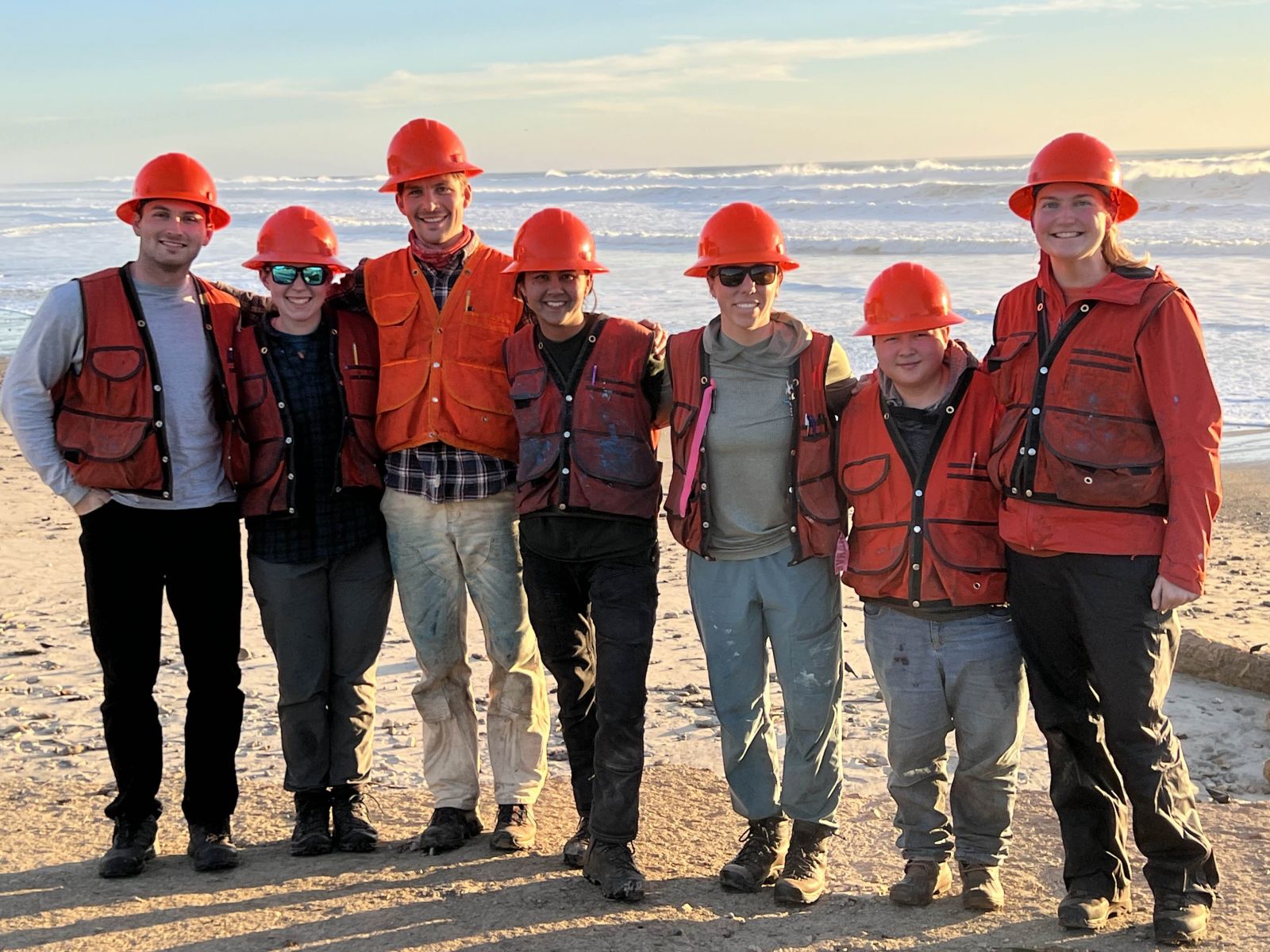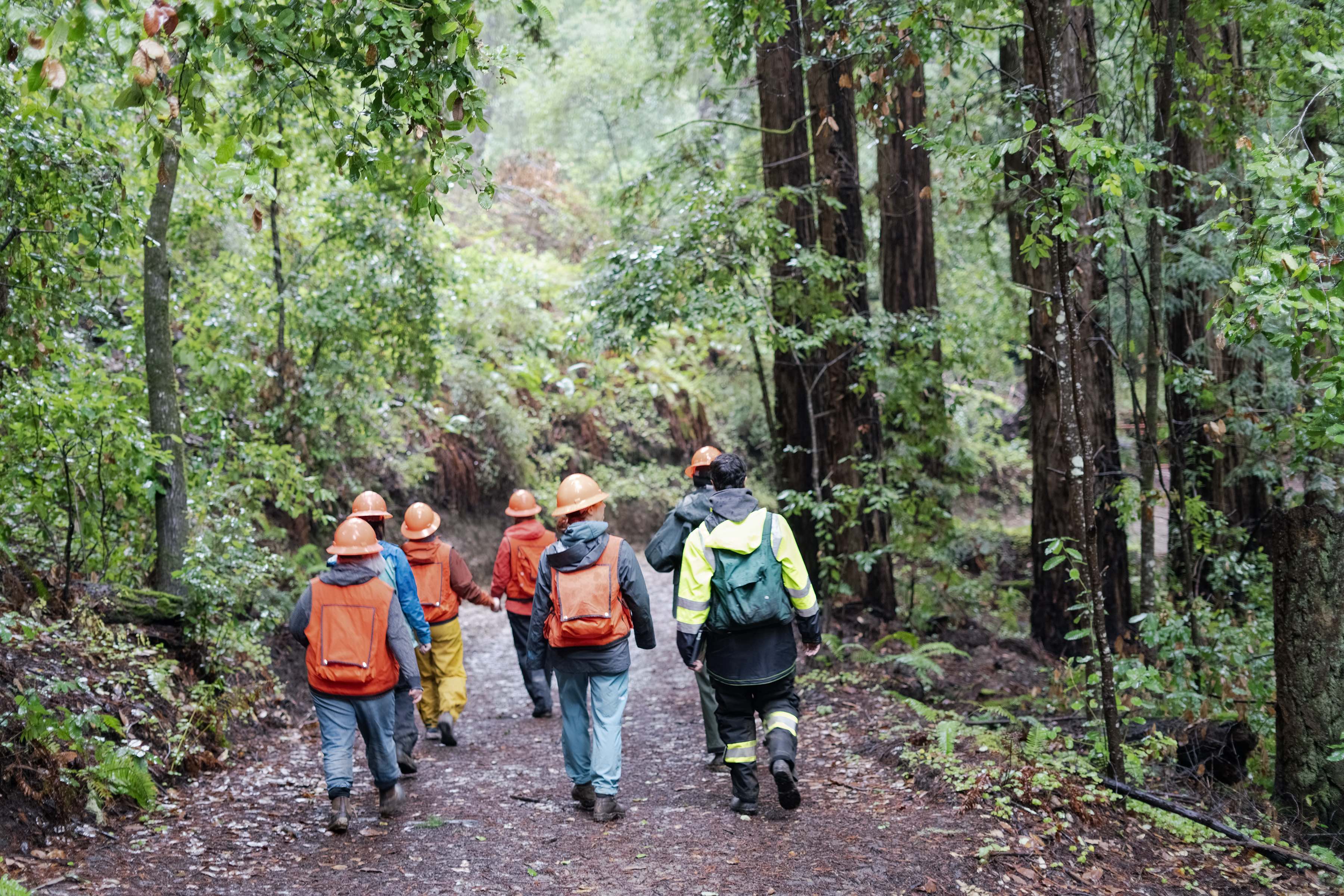
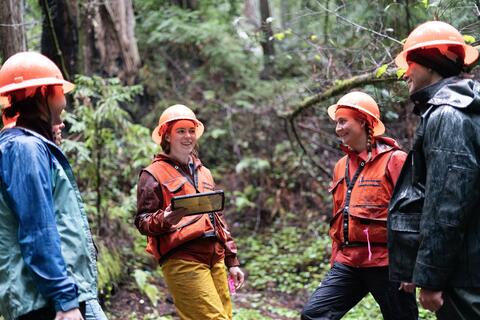
Yale Forests’ Forest Manager Grace Bachmann ’23 MF led the “Western Forest Crew: Redwood Forest Restoration and Management with Save the Redwoods League” over winter break 2023-24. Crew members include Austin Pruitt ‘24 MF, Mary Katherine DeWane ‘24 MF/MBA, Jake Barker ‘24 MF, Shaylyn Austin ‘23 MF, Grace Bachmann ‘23 MF, Julia Chen ‘24 MF, and Diana Satkauskas ‘24 MF (below, from left).
By: Grace Bachmann ’23 MF
Crew Summary
We were ushered into the Santa Cruz mountains by the rains of late December, either a persistent mist in the draws or a winter torrent that rendered even the most rugged rain gear wet in minutes. This precipitation is the key to the soaring coastal redwoods in the area and nurtures the surviving trees from the CZU Lightning Fire Complex in 2020. Our first hours were spent on a property that had not burned in 2020, providing a vision and resemblance of what the main project area [San Vicente] had looked like before the fire. Though separated by mountains and ridges, we held this forest in mind as we navigated thick brush and redwood sprouts in the burn scar to measure trees and implement a prescription. If all goes to plan and Save the Redwoods League completes work on schedule, the forest of the project area will regain its canopy and be more resilient to any subsequent fires in the coming few years.
—Jake Barker ‘24 MF
Day 1: Days before our arrival, Ben Blom ’10 MF, director of stewardship and restoration at Save the Redwoods League, notified us of a storm system coming into the Santa Cruz area that would impact our schedule for the first few days. So, on December 27, we headed directly to a Save the Redwoods property, Peters Creek, to learn coast redwood silviculture and ecology. We spent the morning with Blom hiking through the forest in the rain, joined by Bay Area alum Kyle Lemle MF ’22. Blom was an incredible resource, leading us in discussions about the uniqueness of redwood trees—their resprouting and asexual reproduction, shade intolerance, foliar uptake (ability to absorb fog), carbon storage capacity, high proportion of heartwood, and more. He also introduced us to the history, structure, and current goals of Save the Redwoods League.
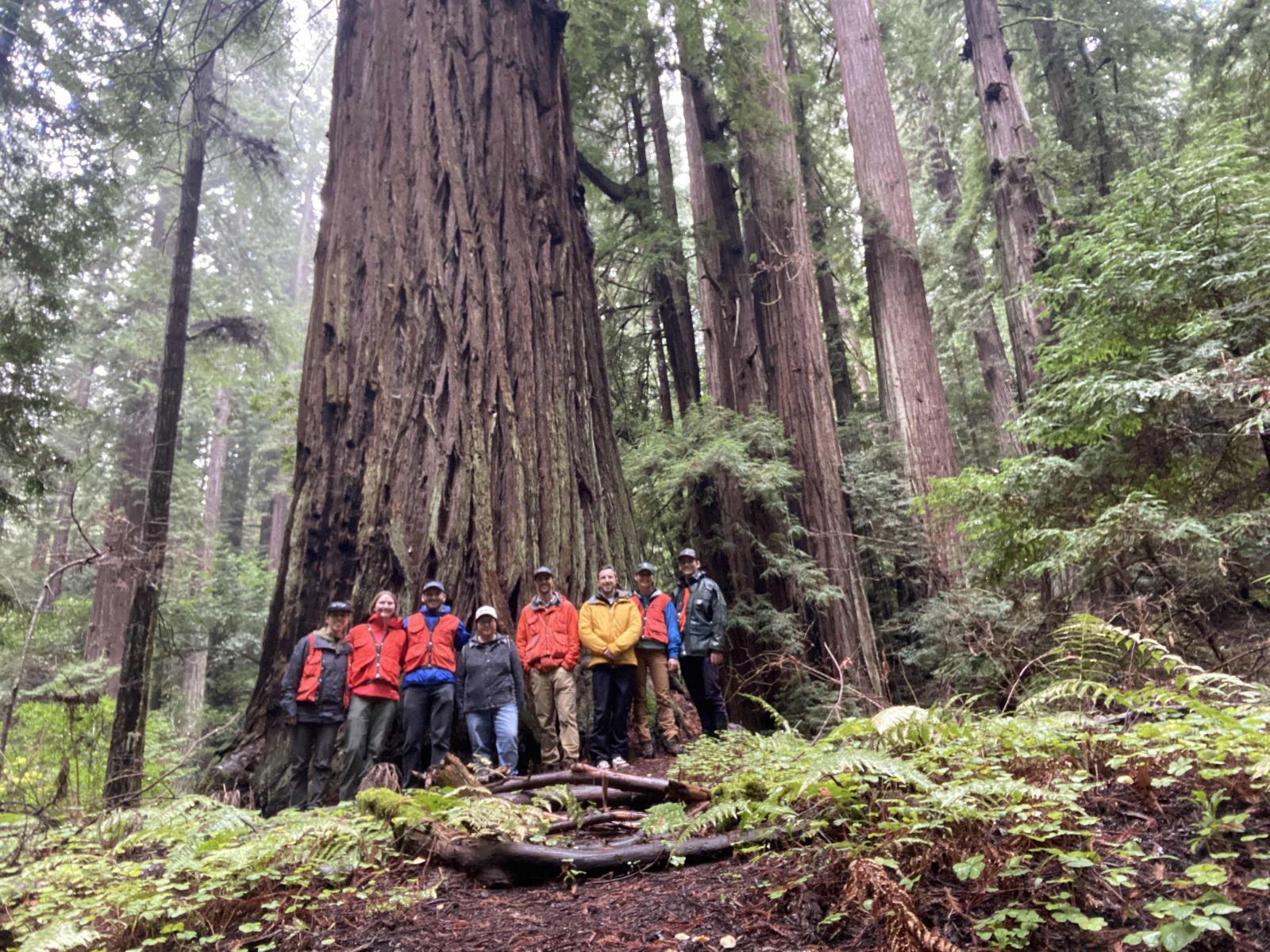
The largest redwood tree at Peters Creek towers over the Western Crew. Photo: Grace Bachmann.
Day 2: Equipped by Blom’s tutorial and with rain gear, hardhats, and cruising vests, we met up with Blom, Anthony Castaños (Land Stewardship Manager, Save the Redwoods League), Nadia Hamey (Registered Professional Forester, Consulting Forester, Hamey Woods), and Kristy Peterson (Registered Professional Forester, Hamey Woods) at a local café to regroup before our nearly two hour commute into the mountains where we would spend the day learning the post-fire restoration prescription in San Vicente. We prepared paint guns for marking removal trees, grabbed Biltmore sticks for measuring tree diameter at breast height (DBH), and then hiked on an old logging road into the restoration area. As a group, we congregated around a cluster of redwood trees—sometimes called a fairy ring—and discussed which trees to mark according to the redwood thinning prescription.
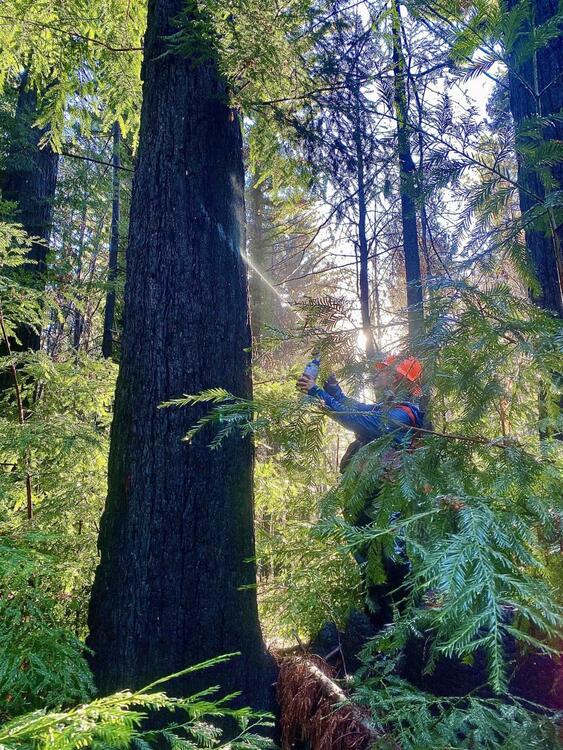
The Crew marks a thinning in the coast redwoods to promote their regeneration. Photo: Grace Bachmann.
San Vicente Restoration Description: This coast redwood and hardwood forest parcel has experienced two major types of disturbance in the colonial era: 1) logging of large diameter redwood trees and 2) high severity fire, including crown fire after a period of fire exclusion. The 2020 CZU Fire swept through the Santa Cruz mountains, killing a high percentage of Douglas-fir, tanoak, and other species, and decimating the crowns of coast redwoods, in some cases killing smaller diameter trees. We were tasked with helping Save the Redwoods League conduct the field preparation work for future implementation of a restoration thinning treatment. This treatment aims to promote the health and vigor of the most resistant redwood individuals so that they have ample water and nutrients from the soil and space to grow by abating competition of the smaller, denser trees, resulting in a redwood canopy that shades out the overly dense, brushy ceanothus understory.
Save the Redwoods League and its partner organizations plan to reintroduce prescribed burning here over time—frequent, low-intensity fires that reduce the risk of future high severity crown fires. In carrying out the restoration treatment, we used timber marking paint to designate redwood trees to be cut down. We selected trees for removal whose canopies are crowding out and competing with those of the most vigorous, prominent, and resilient trees. We also marked smaller diameter trees that will later reduce the vigor of dominant trees, because coast redwoods are shade-tolerant and can persist beneath and through the shade provided by dominant canopy trees.
Day 3: Due to the heavy rains and high winds, we spent the day in the city of Santa Cruz where Ben Blom treated us to lunch.
Day 4: After the rains settled, our seven-person crew set out, self-guided, to continue marking the thinning in San Vicente. With safety procedures in place, we set off in pairs or groups of three and headed to the furthest section of the water course protection zone. We focused there because Nadia Hamey, the forester leading this project, will show the most sensitive areas to the agency responsible for approving the treatment.
The newness and novelty of the terrain faded quickly, and we began to appreciate the endurance and grit required to work in a place like San Vicente. The slopes were steep and the soil often loose and unstable. Where there were not snags or redwood clusters, we were met with walls of ceanothus, a native shrub growing at least six feet tall. During or after a rain, bushwacking through ceanothus meant getting soaked immediately. We spent our days at San Vicente bushwacking through brush and dense redwood regrowth within the redwood “fairy ring.” To measure DBH and mark the tree, we could be no further than two feet from its base.
Dec. 31-Jan. 1: The crew enjoyed days off in Santa Cruz and San Francisco.
Days 5-6: We returned to San Vicente and a sunny, dry day on Day 5 but limited to a half day of work due to wind and rain on Day 6. For the rest of the day, we headed to Cascade Creek where Anthony Castaños showed us how the CZU Lightning Complex affected this forest more proximate to the coast.
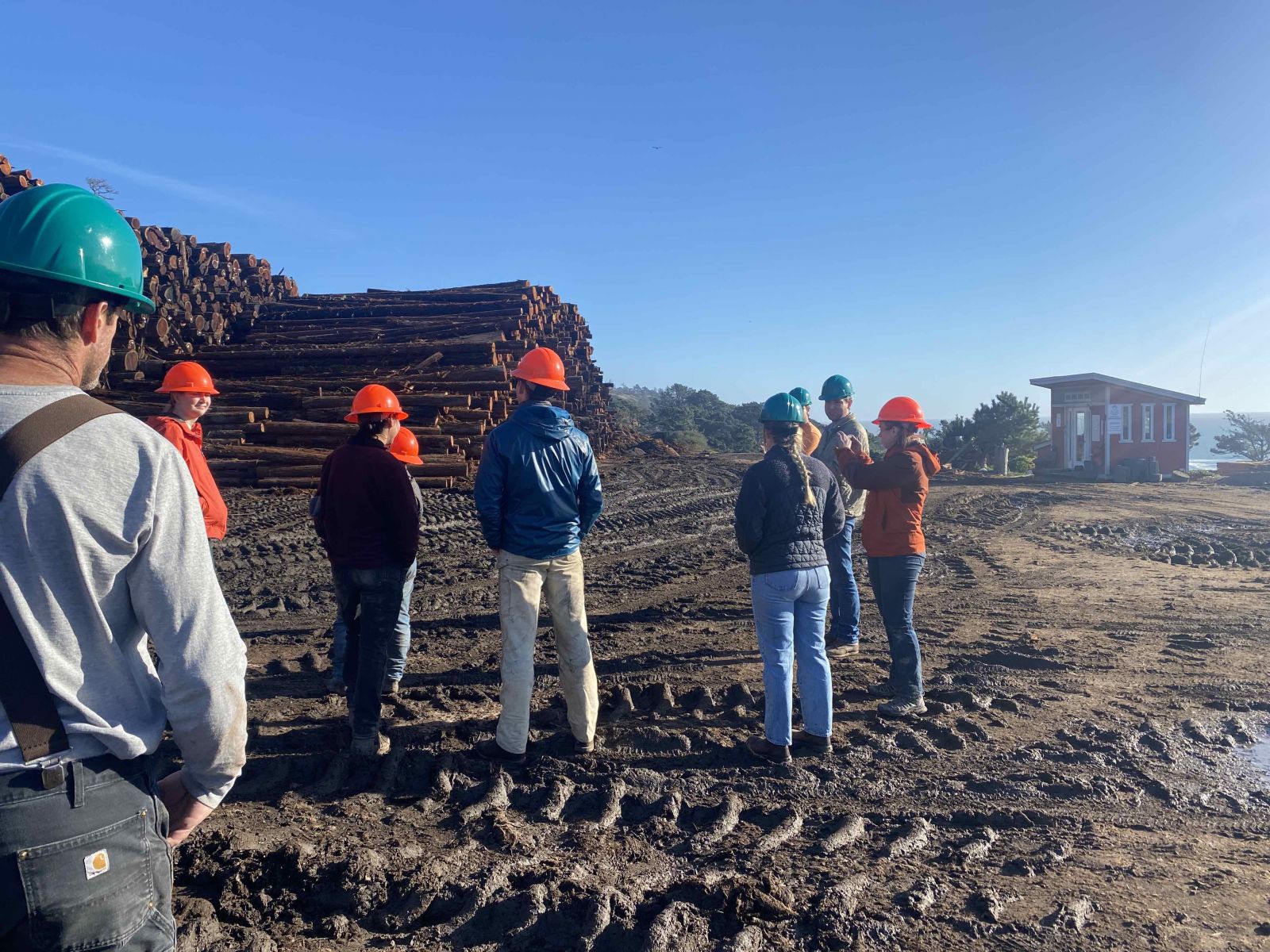
Mary Katherine DeWane poses a question to Dennis Webb (second from right), forester for Big Creek Lumber, during a mill tour with views of the Pacific Ocean in the background. Photo: Grace Bachmann.
Days 7-9: We spent part of Day 7 flagging the shaded fuel break in preparation for a future prescribed burn treatment and then headed off to Big Creek Lumber for a mill tour and conversation with their forester. Days 8 and 9 brought us back to San Vicente to mark the thinning with Sempervirens Fund and Peninsula Open Space Trust colleagues.
Jan. 7: Crew enjoyed a day off before their last week of work.
Days 10-12: We spent Days 10 and 11 making our last efforts at San Vicente. On Day 12, our final day, we returned to Peters Creek where the experience began, this time to flag the shaded fuel break along the road. Lynn Robb, LA-based photographer, bravely accompanied us on Days 11 and 12.
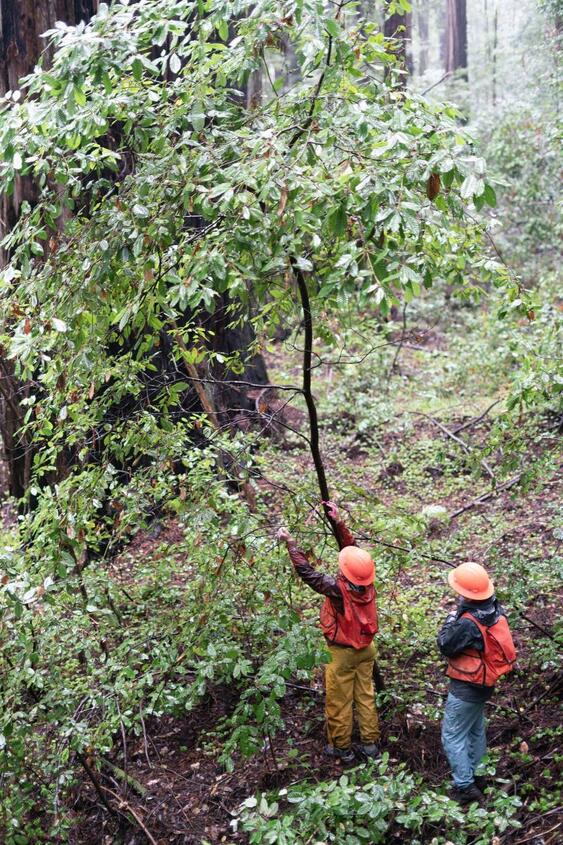
The Crew flags in pairs at Peters Creek. Photo: Lynn Robb.
Peters Creek Site Preparation Description: This Save the Redwoods League property has not experienced catastrophic fire but was selectively logged in the past. To reduce the risk of crown fire in the future, Castaños and his team plan to also reintroduce frequent, low intensity fires here. In preparation for prescribed fire, shaded fuel breaks—where lighter fuel loads along linear features like historic logging roads and ridgelines progressively decrease a fire’s intensity—are needed along roads and paths. These breaks will serve as control lines for designating units for the future prescribed burns. Our task was to use neon flagging to designate where the shaded fuel break ends, approximately 100 feet on either side of the road or path.
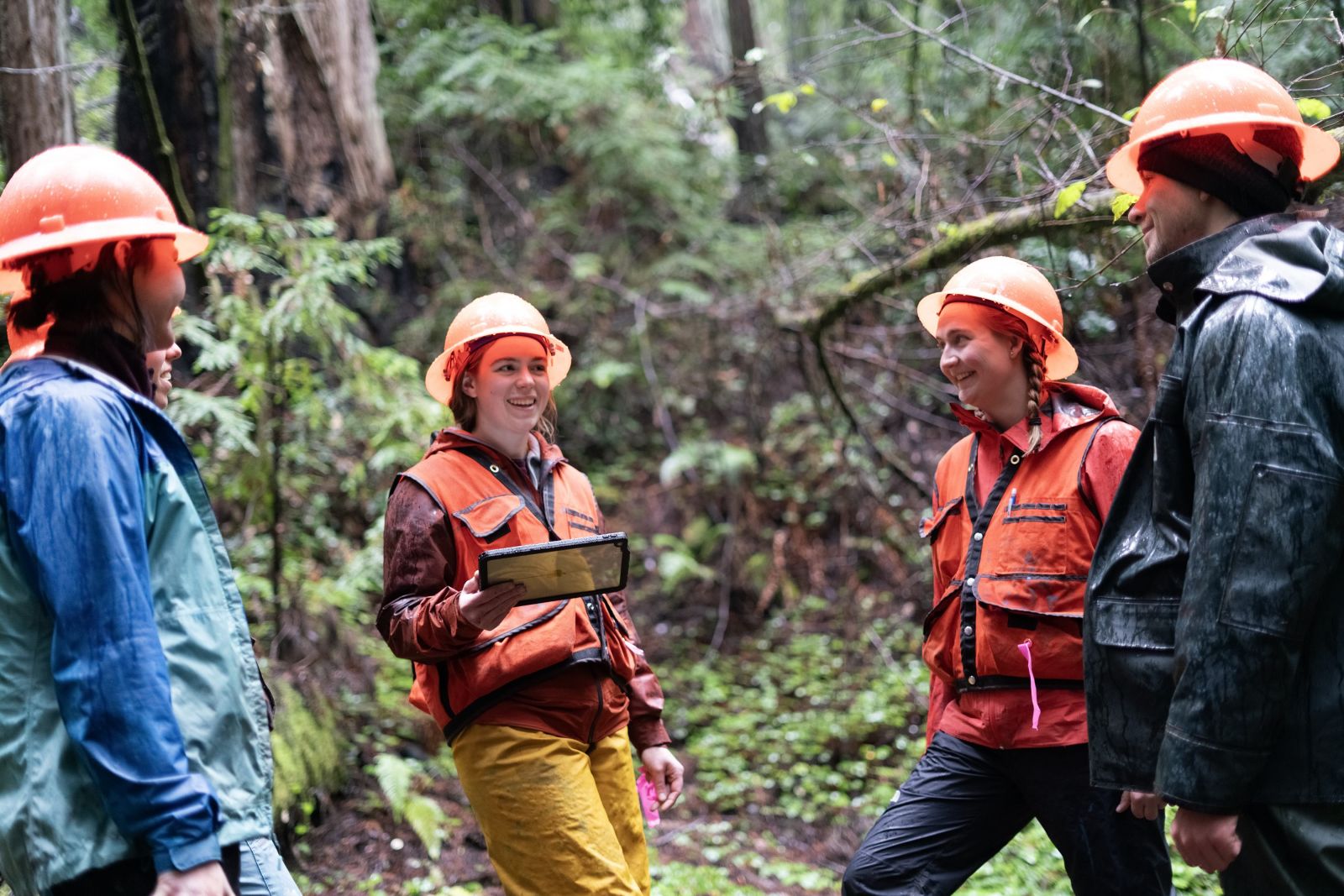
Shaylyn Austin (left), Mary Katherine DeWane, Diana Satkauskas, and Jake Barker discuss next steps in the silviculture prescription. Photo: Lynn Robb.
Header image: Save the Redwoods League introduces the Western Crew to the coast redwoods. Photo: Lynn Robb.
